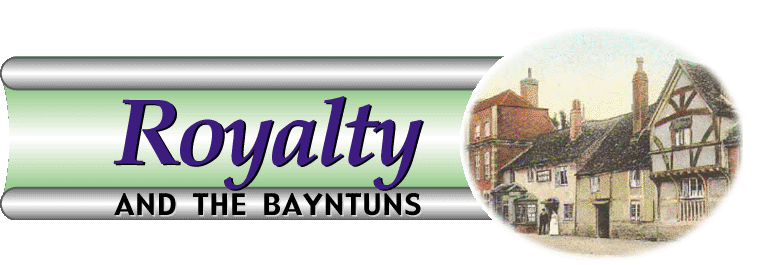

|
Robert Bayntun was attained after the Battle of Tewkesbury, charged with high treason, declared a traitor, lost all of his property and died in custody |
Before 1189, Sir Henry Bayntun was said to have been a Knight of St John of Jerusalem and held the office of Knight Marshall of the Household to King Henry II – which was a post of great trust and authority in those days. During his reign he took part with the Earl of Northumberland, and as a result, was beheaded at Berwick. His second son, Henry, was also a Knight of St. John of Jerusalem and was slain in Bretague in 1201. The Bayntun family had long been supporters of the House of Lancaster and as a Partisan, in the Wars of the Roses, Sir Robert Bayntun (1439 - 1473) fought for King Henry VI against the forces of King Edward IV at the Battle of Tewkesbury on May 4, 1471. Henry was defeated and Sir Robert was immediately declared a traitor, thereby losing all his property. After the battle he was made prisoner but was spared, however he died two years later. From the time he was attained, Faulston House and manor ceased to be the home of the Bayntun family for more than 30 years. On July 1 1504, his son, John Bayntun (1460 - 1516) obtained a reversal of the attainder of his father, Robert Bayntun, for high treason committed at Tewkesbury, with a restoration in blood and inheritance and thus recovered the many family manors, including the Manor of Faulston. At Hampton Court, Sir Edward Bayntun (1480 - 1544) stood high in favour with King Henry VIII, where he enjoyed considerable influence and was Vice-Chamberlain to five of his Queens (Ann Boleyn, Jane Seymour, Anne of Cleves, Catherine Howard and Catherine Parr). He seems to have been a Queen's Household man and although it is doubtful if Catherine of Aragon had a Vice-Chamberlain before she became Queen, as she was virtually living on charity, it is believed she and Sir Edward were friends and was a frequent visitor to his house. In 1536 he was entrusted with obtaining confessions from men accused of having had treasonable relations with Queen Anne Boleyn. By King Henry VIII, Sir Edward was deputed to use his private friendship with Cardinal Pole, his cousin, to bring over the prelate to his Majesty's views, but all his endeavors proved unavailing. These were turbulent times and the King had severed relations with Rome and he was confiscating property on a large scale from the monks and friars before selling it off to courtiers, landed gentry and public servants. At the time of the Suppression of the Monasteries, Sir Edward used his influence and accumulated an enormous amount of property and land while at the Court of King Henry VIII which saw him become one of Wiltshire's greatest landowners. There are many documents concerning Sir Edward Bayntun and his second wife, Isabel Leigh and their association with King Henry VIII and his Court. She was the half-sister of Queen Catherine Howard. In early June 1535, King Henry VIII, Queen Anne Boleyn and the rest of his court, left Greenwich Palace for some months and embarked on a route through Gloucestershire and Wiltshire. Local gentlemen who favoured reform, like Sir Edward Bayntun, were singled out for a Royal visit. Thomas Cromwell, the Chancellor, later caught up with the travelling party on 23rd July, when they were guests at Sir Edward's mansion – Bromham House – for more than a week. The King visited Bromham House again, at the invitation of Sir Edward, on 30th September 1535, from where he is said to have dated a letter. The archway, or gatehouse to Sir Edward's house was reconstructed after the demolition of Stanley Abbey in Wiltshire, on the instructions of Queen Catherine of Aragon as a gift and expression of gratitude to her friend for some time, Sir Edward. It still bears the royal arms of the Tudors beneath the oriel window in the upper storey. In November 1541 when Queen Catherine Howard was banished by Henry VIII from Hampton Court to Syon Abbey, she took only four ladies-in-waiting – one of whom was Lady Isabel Bayntun, Sir Edward's second wife. Syon Abbey was originally the site of a Monastery and Catherine was held there before her execution on 13th February 1542. Sir Edward and Isabel were present at the marriage of King Henry and Katherine Parr at Hampton Court on July 12th 1543. He attended this Royal Master in his expeditions and is supposed to have died in France during the ill-considered invasion in 1544. Sir Edward Bayntun (1593 - 1657) was a Commissioner in the Trial of Charles I, but did not act. Evidence exists in town records that King James I visited Bromham House three times in 1618, 1620 and stayed there again from 29th to 31st July 1623. In 1618, the Chamberlain's books from the Devizes Corporation show that certain items were lent to Sir Edward for this visit to Bromham House and that the Corporation paid for the wine given to the King's Trumpeters. In October 1642
Sir Edward became Commander-in-Chief for Wiltshire County and he commanded
a force for Parliament in the early part of the Civil War and was a
Commissioner of the English Parliament to the Scots Army, but withdrew
from active soldiering after a quarrel with his neighbour and fellow
Commander, Sir Edward Hungerford. He subsequently made approaches to
the King, for which he was imprisoned for some time in the Tower. |
|
|
|